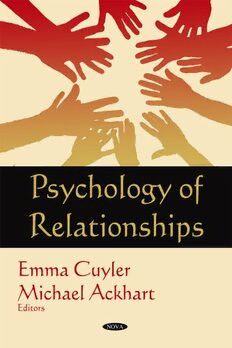
Psychology of Relationships PDF
604 Pages·2008·5.622 MB·English
Most books are stored in the elastic cloud where traffic is expensive. For this reason, we have a limit on daily download.
Preview Psychology of Relationships
Description:
This book describes the various aspects of interpersonal relationships, which can be defined as the interactions between one group and another. How people represent their interpersonal relationships based on past experiences is explored, as well as the three main aspects of interpersonal representations- structure, content, and nature. Conflictive social interpersonal relationships and how they influence mental health are explored in this chapter, as well as the different coping styles people have. In addition, the various dimensions of empathy and how they relate to interpersonal relationships are reviewed and incorporated into a unified source of reference for future research. The role of the nonapeptide called oxytocin in the pathophysiology of attachment is described as well as the possible involvement of oxytocin in the onset of mental disorders.Differences in romantic relationship intimacy, resulting from identity exploration are discussed, as well as the differences in commitment based on gender. In addition, the correlation(s) between relationship adjustment, satisfaction, and quality are reviewed based on the Relationship Quality Interview (RQI), which assesses relationship quality across five dimensions, including trust, inter-partner support, quality of intimacy, respect, and communication. Furthermore, the association between social relationships and physical health is examined. The tendency to forgive in premarital couples is examined as well as the reasons behind forgiveness- possibly deriving from parental model behaviour or reciprocation of the partner's behaviour. In addition, a review of studies is done on the relationship between serotonin levels and romantic love, as well as how the thoughts of infatuated individuals mirror those who suffer from obsessive-compulsive disorder.Furthermore, generalised anxiety disorder (GAD), one of the more common anxiety disorders, is discussed and how it affects occupational, interpersonal and family functioning, as well as the different treatments for GAD. This book presents the most up-to-date information on pheromone research, including how pheromones may influence reproductive endocrinology and have a positive effect on one's mood. In addition, the differences between normal and obsessional jealousy is explored, as well as the role that neurotransmitters may play in the expression of jealousy. The neurobiological correlates of attachment in both animals and humans is examined, including infant-mother attachment, mother-infant attachment, adult-adult pair bonding formation, and human bonding.Human-pet relationships and their importance in the field of human psychology animal are also explained in this book. Furthermore, the relationships between co-operative and non-co-operative or competitive behaviour in pairs of children in the ongoing process of interaction is reviewed. The social networking and psychosocial functioning among children and adolescents coping, in particular, with sickle cell disease is examined in this book, as well as the best practices for treatment.
See more
The list of books you might like
Most books are stored in the elastic cloud where traffic is expensive. For this reason, we have a limit on daily download.
